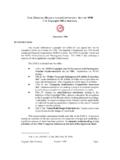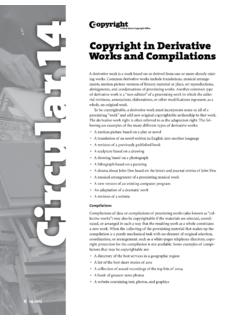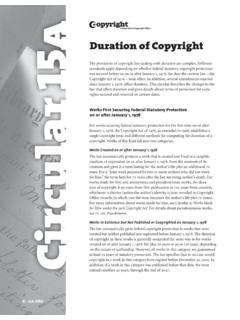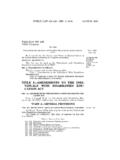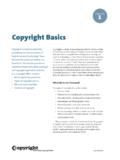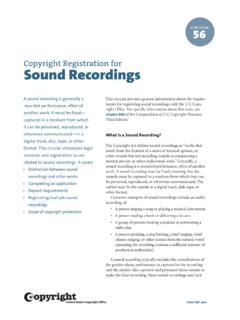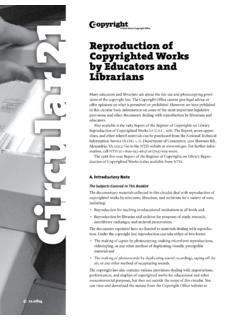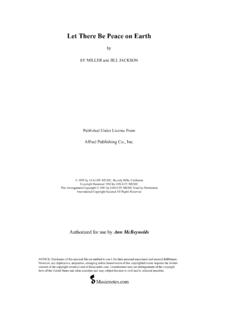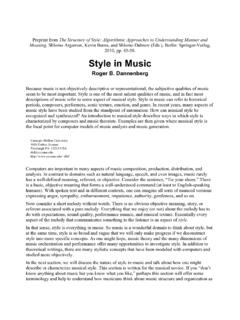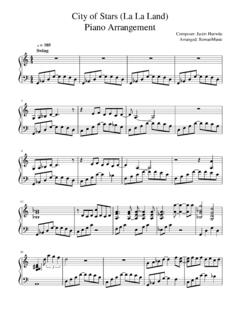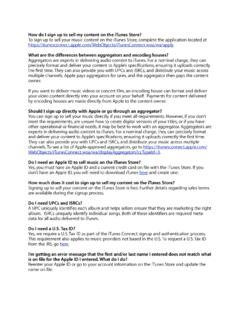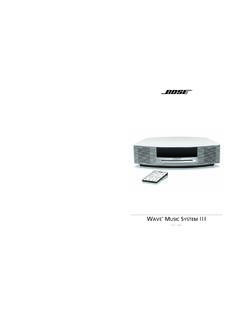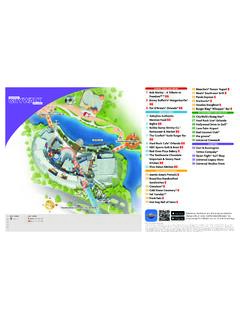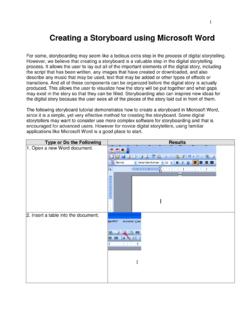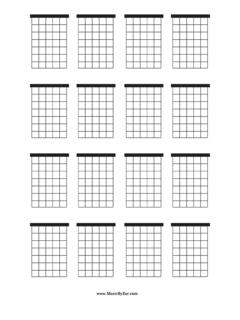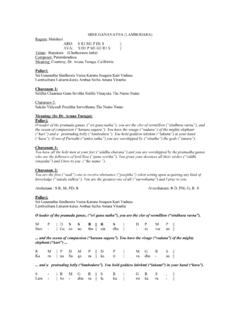Transcription of Circular 50 Copyright Registration for Musical Compositions
1 50 This Circular is intended as a guide to registering Musical Compositions with the Copyright Office. For specific information, see chapter 800 of the Compendium of Copyright CompositionsThe Copyright Act provides in section 102(a)(2) for copy-right protection in Musical works, including any accom-panying words, that are fixed in some tangible medium of expression. Musical works include original Compositions and original arrangements or other new versions of earlier Compositions to which new copyrightable authorship has been protection gives the owner of Copyright in a Musical composition the exclusive right to make copies, pre-pare derivative works, sell or distribute copies, and perform or display the work publicly.
2 The owner of Copyright may also authorize others to exercise the exclusive Copyright in a Musical work includes the right to make and distribute, or to authorize, the first sound record-ing of a performance of the Musical composition. Once a Musical composition is published in the United States on phonorecords, others are permitted to make subsequent sound recordings of the Musical composition subject to a compulsory licensing provision in the Copyright For more information, see Compulsory License for Making and Distributing Phonorecords ( Circular 73). Musical Compositions Versus Sound RecordingsA Musical composition and a sound recording are two sepa-rate works. A Registration for a Musical composition covers the music and lyrics, if any, embodied in that composition, but it does not cover a recorded performance of that composition.
3 This Circular provides information about registering Musical Compositions with the Copyright Office. It introduces the difference between a Musical composition and a sound recording under Copyright law and offers guidance about Completing a Copyright application Submitting a deposit Registering multiple unpublished Musical compositionsCopyright Registration forMusical CompositionsCopyright Registration for Musical Compositions2 For example, the song Rolling in the Deep and a recording of Aretha Franklin singing Rolling in the Deep are two distinct works. The song itself ( , the music and the lyrics) is a Musical composi-tion, and a recording of an artist performing that song is a sound most cases, a Musical composition and a sound recording must be registered separately with the Copyright Office.
4 However, in limited circumstances, a sound recording and the underlying Musical composition can be registered with one application, filing fee, and deposit. For information about registering a sound recording, see Circular 56. For information about registering a Musical composition together with a sound recording, see Circular RegistrationTo register a claim to Copyright in a Musical composition, you must submit the following to the Copyright Office: (1) a completed application form; (2) a nonrefundable filing fee; and (3) the required deposit copies of your work. This Circular highlights issues common to registrations of Musical Compositions . For more guidance on registering a Musical composition, see chapter 800, section , of the Compendium.
5 For general Registration information, see Copyright Registration ( Circular 2).note: Copyright Office fees are subject to change. For current fees, see Copyright Office Fees ( Circular 4), available on the Office s website at or call the Office at (202) 707-3000 or 1-877-476-0778 (toll free).Mistakes in applications lead to delays in Registration , so it is important to complete the appli-cation accurately. Instructions for completing an online application appear in the help text that accompanies the application. Here are some tips regarding common points of of Work At the beginning of the application, select Work of the Performing Arts on the Type of Work screen. The questions in the application are based on the type of work you select.
6 If you select the wrong option, you will need to start Provide the title of the Musical composition you are registering exactly as it appears on the work Publication occurs when copies or phonorecords of a work are distributed to the public by sale or other transfer of ownership or by rental, lease, or lending. Publication also occurs when a Copyright owner offers to distribute copies or phonorecords of a work to a group of persons for the purpose of further distribution, public performance, or public display. A public performance or display of a Musical composition does not, in and of itself, constitute publication. If the work has not been published, state that the work is unpublished. If the work has been published, give the month, day, and year that the copies or phonorecords were first distributed to the public or first offered to a group of persons for further distribu-tion, public performance, or public Registration for Musical Compositions3 Year of CompletionThe year of completion is the year in which the version of the work you are registering was first fixed in writing or recorded in any other tangible form.
7 If you are registering a work that was written or recorded over a period of time, or a work that constitutes a new version of an earlier work, give the year of completion of the final work or new author of a Musical composition is the person who wrote or created the music and lyrics, if any, unless the work is a work made for hire. If the music was created as a work made for hire, give the name of the employer, not the person who actually created the : Check Made for Hire only if the work was prepared by an employee within the scope of his or her employment or commissioned by a third party (1) as a contribution to a compilation or a collective work, (2) as part of a motion picture or other audiovisual work, or (3) as a Musical arrange-ment with an express written agreement signed by both parties that the work would be considered a work made for hire.
8 For more information, see Works Made for Hire ( Circular 30).Type of Authorship Specify what the author created in the copy or phonorecord that accompanies the application. If you are registering a Musical composition, you can describe authorship in terms of the lyrics, the music , and/or the Musical arrangement. If you are also registering artwork, photographs, or liner notes that appear on the copy or pho-norecord, include a brief statement to that effect in the Other field. If you are registering a compilation or a collective work, such as an album, describe the authorship and the material included in the claim by stating Compilation of Musical Compo-sitions in the Other : Do not include elements that are not present in the copy or phonorecord.
9 Do not include ele-ments that are not protected by Copyright , such as ideas, concepts, names, or of Claim If you are registering a Musical work that contains preexisting material, identify that material in the Material Excluded field, and identify the new material in the New Material Included field. If the preexisting material has been registered with the Copyright Office, include the reg-istration number and year. Complete this space only if the work being registered contains an appreciable amount of material that was previously published; was previously registered in the Copyright Office; is in the public domain; or is not owned by the claimant named in the application. Copyright Registration for Musical Compositions4 Leave this space blank if the work does not contain an appreciable amount of any of this kind of material.
10 For more information, see chapter 500, section 507 of the RequirementsTo register your Musical composition, you must send a deposit of the work to the Copyright Office. This deposit should be a complete copy of the work being registered. A complete copy means that the deposit is legible, is assembled in orderly form, is labeled with the title of the work, and includes everything to be covered by the Registration . Where possible, the Copyright Office encourages you to upload the deposit in an acceptable file format through the online Registration system. Deposits may also be mailed to the Office following the directions in the shipping slip generated from the Submit Your Work screen. Once a deposit has been submitted, it becomes part of the public record and cannot be you submit your deposit depends on the format in which the Musical composition is pro-duced and whether and where it is published.

